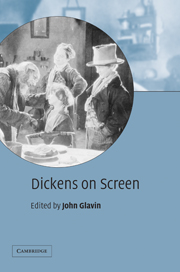Book contents
- Frontmatter
- Contents
- List of illustrations
- Notes on the contributors
- Acknowledgments
- Introduction
- Part I
- Part II
- 2 David Copperfield's home movies
- 3 David Lean's Great Expectations
- 4 Great Expectations on Australian television
- 5 Dickens's “The Signalman” and Rubini's La stazione
- 6 Bill Murray's Christmas Carols
- 7 Screen memories in Dickens and Woody Allen
- Part III
- Part IV
- Part V
- Index
- References
5 - Dickens's “The Signalman” and Rubini's La stazione
Published online by Cambridge University Press: 22 September 2009
- Frontmatter
- Contents
- List of illustrations
- Notes on the contributors
- Acknowledgments
- Introduction
- Part I
- Part II
- 2 David Copperfield's home movies
- 3 David Lean's Great Expectations
- 4 Great Expectations on Australian television
- 5 Dickens's “The Signalman” and Rubini's La stazione
- 6 Bill Murray's Christmas Carols
- 7 Screen memories in Dickens and Woody Allen
- Part III
- Part IV
- Part V
- Index
- References
Summary
Only recently has Italian academic criticism started to produce significant studies of Charles Dickens's fiction. Yet, despite this lack of academic attention, Dickens has proved a strong seller in the Italian marketplace. Writing recently on Dickens and the Italian cultural scene, Carlo Pagetti has listed a number of novelists, from Edmondo de Amicis to Italo Calvino, who owe something to Dickens (in Bonadei and de Stasio 2000: 13–30). Francesco Casotti even claims that “in Italy Dickens is not only popular but … he has become also a permanent feature of the Italian cultural background” (1999: 22). So far nobody has tried to explain why a Victorian writer can be so popular in Italy, where Trollope or, to a lesser extent, George Eliot are almost unknown. I suspect it depends on the fact that Dickens is often considered a children's novelist. In fact, with the exceptions of Collodi and Salgari, whose pirate stories are considered unfit for girls, Italian literature lacks children's novels. Dickens is therefore often resorted to as a present for boys and girls on their tenth to fifteenth birthdays. In Dickensian characters Italian teenagers can find a dramatization of adult life in a reassuringly faraway world. Once grown up, Dickens's characters enter the Italian cultural metabolism and become archetypes, the “permanent feature” mentioned by Casotti. It is probably no coincidence that the other Victorian bestseller in Italy is Lewis Carroll.
- Type
- Chapter
- Information
- Dickens on Screen , pp. 53 - 60Publisher: Cambridge University PressPrint publication year: 2003



